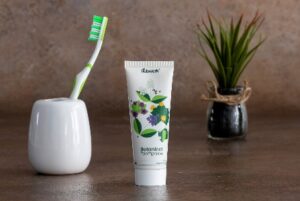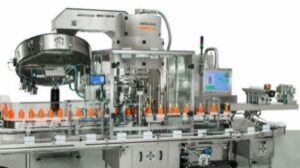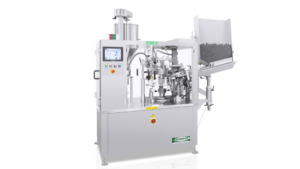The Changing Face of Cosmetics Packaging
By Doris Bünnagel, a freelance editor specializing in packaging
Sustainability has been a mega-trend in the field of cosmetics and personal care packaging for years. Manufacturers are increasingly using packaging made from recyclable mono-materials, paper and renewable raw materials — often from waste products from agriculture, forestry or the food industry. Refillable solutions are also being favorably received by consumers, as more people try to reduce the amount of household waste they produce.
Various new forms of sustainable packaging are being used for both conventional and natural cosmetic products. And one thing is certain: Natural cosmetics are on the rise. In fact, the strong growth within the natural cosmetics market is cutting into the market share of conventional cosmetics, according to online statistics platform Statista. The U.S. is the largest worldwide market for natural cosmetics. In Europe, Germany is number one when it comes to natural body and beauty care followed by France and Italy.
Sustainable consumption

Hand cream in a paper tube by Stora Enso, coated with an EVOH barrier up to now only common for boxes for beverages. Image: Kneipp
Today, hardly any manufacturer can ignore the general sustainability trend, because whether natural cosmetics or not, consumers want sustainably packaged beauty and care products, preferably without any plastic at all. Therefore some time ago, interpack exhibitor Stora Enso developed a new composite paper for the cosmetics industry, from which partners then create tube packaging for hand creams, for example.
The composite paper is coated with an ethylene-vinyl alcohol (EVOH) barrier, which until now has only been used for beverage cardboard boxes. The tubes can be decorated with high quality digital printing. One manufacturer of natural cosmetics is the first to also use the technology for marketing purposes, as the use of a special software allows for the realization of unlimited design variations during digital printing. Each tube thus becomes a unique piece of art.
Hard soap and shampoo bars or natural cosmetic powder that can be easily mixed with water at home to become body or hair care, are currently popular and save packaging. But liquid products in bottles made from recyclates or refills in bags made from mono-materials are also popular with consumers right now.
A tube by interpack exhibitor Hoffman Neopac is part of the trend towards sustainability since it is made of more than 95% renewable resources, and 10% pine wood. The wood dust component gives the surface of the so-called Picea tube a slightly rough finish. Regarding barrier function, decoration, food safety or recyclability, it offers the same properties as conventional polyethylene (PE) tubes. The pine wood used is sourced from certified forests within the EU and the wood fibers come from waste saw dust from German carpenters’ workshops.

The Picea tube with a pine wood component was awarded in the “Tube of the Year 2022” competition by the European Tube Manufactures Association (etma). Image: etma
Alternative materials
A small contribution to solving the problem of plastic waste in the ocean is the goal of a new material for labels, produced by UPM Raflatac from certified circular polypropylene (PP) polymers by Sabic. This Ocean Plastic is collected and turned to pyrolysis oil during a specialized recycling process. Sabic uses this oil as an alternative raw material to produce certified circular PP polymer, which is then processed further into foil, from which UPM Raflatac then manufactures the new material for labels. It is certified according to the requirements of the International Sustainability & Carbon Certification (ISCC) program. Since the certified circular PP from Sabic has the same qualities as PP newly made from mineral oil, the conversion does not require any changes to the production processes for the foil and label materials.
Less packaging waste with refilling systems
Used once and then discarded, this is also the fate of most single use cosmetics and body care packaging. A number of manufacturers want to counteract this using refilling systems. As an alternative to disposable packaging, these help to save packaging material as well as transport and logistics costs. In many countries, such refilling systems are already widespread. In Japan, it’s simply part of daily life to buy liquid soap, shampoo and household cleaning products in thin foil bags and then pour them into dispensers at home or use a special attachment to turn the refill units into directly usable primary packaging.
However, refillable solutions are more than just recyclable refill packs. Drugstores and supermarkets are already testing filling stations and experimenting with how customers accept the offer to fill their own personal care products, cleaners, detergents and dishwashing liquid. Customers can either bring their own containers or buy them in the store. There are also the first concrete plans for a deposit system for cosmetics packaging. It is intended to work through a cooperation between packaging and brand manufacturers and waste disposal companies: while some collect used cosmetics packaging, others recycle them and the recyclate is then turned into new packaging by other partners.
Energy efficient filling

The Robomat filling line, combined with a closing machine, automatically mounts widely different closures on filled bottles of cosmetics.
Image: Rationator
The growing number of individual formats as well as a multitude of new cosmetic products create increasing requirements for filling. Mechanical engineering company Rationator specializes in modular filling lines and for example combines their Robomat filling line with a type Robocap closing machine, to automatically mount widely different closures, for example screw caps, push caps or spray and dosing pumps, on filled bottles of cosmetics. This new generation of machines also focuses on sustainability and efficient use of energy.
The growing cosmetics sector also accounts for an increasing share of sales at the Marchesini Group. The group’s Beauty Division is now able to cover the entire production cycle of a cosmetic product with their machines. New models also wrap cosmetics products in environmentally friendly materials, for example machines for boxing products in cardboard trays, or thermoforming and blister wrap machines for producing blisters and trays from polyactic acid (PLA ) made from plant extracts, recycled polyethylene terephthalate (rPET), or stickpack lines using 100% recyclable plastic mono-materials.
Flexibility is also in demand. Schubert Cosmetics therefore has recently developed a monoblock bottle filling system for a cosmetics manufacturer, which covers a wide range of shapes. The respective portfolio currently covers eleven different filling media with widely different viscosity, which must be filled into five plastic and two glass bottle shapes.
A single shape can again contain up to three single components, like bottle, pump and sealed lid. The new system integrates the entire filling and packaging procedure into a single line. In directly following steps, plastic and glass bottles are cleaned, precisely filled, sealed with a lid and packaged in pre-glued automatic side load folding boxes. The high requirements regarding completeness and intactness of the products and their packaging are met through the installation of several camera systems that inspect the products at various points in the process and discard them as needed, without interrupting the packaging process.
The basis of this especially easy and cost-attractive format change is 3D printing by the Schubert platform “Partbox”. This allows manufacturers of cosmetics to produce their own spare or new format parts. With few exceptions, this way all changeable parts are able to be easily reproduced. This includes, for example, grippers for pipettes as well as trays for the containers.

A new tube filling machine automatically fills and closes plastic, laminated and aluminum tubes. Image: Marchesini Group
Traceable and reliably labeled packages
Packaging for cosmetics can be really small. Lip balm sticks for example don’t offer much surface area, but still need to be labeled. Handling these small products for optimum alignment during the labeling process can quickly become a challenge. Labeling specialist Bluhm Systeme has therefore developed a specialized system for labelling and printing very small cosmetics products.
The new Geset 700 labelling system consists of a label dispenser, a laser marker and related transport technology. Up to 150 cylindrical cosmetic products per minute are labelled by the system, using preprinted labels and individual batch numbers. The new system reliably transports the small cylindrical products throughout the entire marking process: A vibration belt transports the upright sticks to a product turner, which turns them 90 degrees using a spiral. In the lying position, the products pass over so-called prism rollers, which transport them through the system at a predefined distance from each other. To ensure traceability, the lip balm sticks must receive individualized batch information. A laser marker adds this data to the labels before these are issued by the dispenser. For safety reasons, a camera then immediately validates the printed information.
Learn more at interpack 2023
Visitors at interpack 2023, the world’s leading trade fair for processing and packaging in Düsseldorf, Germany, will find out what is currently moving the cosmetics industry and what sustainable and future-proof solutions the sector has in store. From May 4 – 10, 2023, exhibitors at interpack will showcase the latest developments in the filling and packaging of cosmetics, personal care and cleaning products in Halls 15, 16 and 17. For ,ore information: www.interpack.com
About the Author
Doris Bünnagel has been working for German packaging media for over 20 years. Since the end of 2019, she has been working as a freelance editor at packaging journal (ella Verlag & Medien). Her favorite topics: environmentally friendly packaging materials, exciting automation solutions and the ideas of young packaging developers. Doris studied natural sciences at the University of Cologne and journalism at the Institute of German Business.







